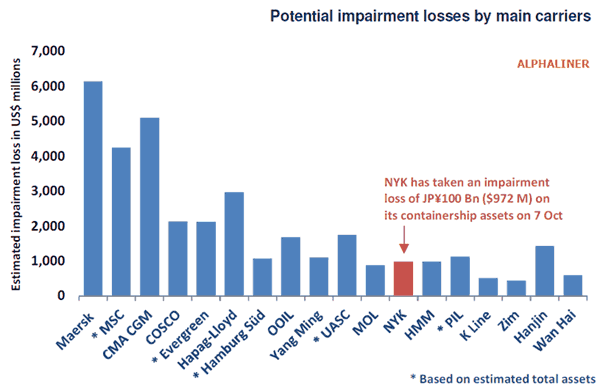Earlier this year, some industry experts thought the rivalries were so strong across the three major Japanese ocean container carriers that they would have a difficult time coming together as part of single consortium in a group of vessel lines.
That view turned out to be off, as Nippon Yusen K.K. (NYK Line), Mitsui O.S.K. Lines and Kawasaki Kisen Kaisha all signed up in May to be part of "THE Alliance" vessel sharing agreement, along with Germany's Hapag-Lloyd; Taiwan's Yang Ming Marine Transport, and the now bankrupt Hanjin Shipping Co. from South Korea. (See That Didn't Take Long - Third Major Container Shipping Alliance Formed that May Ultimately Include All the Orphans.)
Supply Chain Digest Says... |
 |
| Despite all these moves, investment Jefferies said in a recent research note that it expects supply of new ships to continue outpacing demand in 2017. |
 |
What do you say? |
| Click here to send us your comments |
 |
| Click here to see reader feedback |
|
|
Now, under the continued dismal economics of the container shipping sector, the Japanese trio has agreed to a business merger among all three of them.
The brutal operating environment - in which carriers often see rates below variable costs to run the ship - almost inevitably has led to some of the changes now roiling the market.
In addition to the Hanjin bankruptcy - which burst the bubble that carriers could always somehow manage to hang on despite massive financial losses - in the past two years the market has seen China's Cosco Group and China Shipping Group merge, France's CMA CGM, acquire Singapore's Neptune Orient Lines, and Germany's Hapag-Lloyd merge with Dubai-based United Arab Shipping Co.
As with the alliances before them, the hope in these mergers is that the combined companies can reduce operating costs per container to get back to something like profitability. In addition, the mergers will likely result in capacity being taken out of the industry, perhaps moving the supply-demand balance a bit back in the favor of carriers. That after several years of weak demand growth from shippers and much faster increases in industry capacity, as carriers continued to take deliveries of the latest generation of megaships with capacities of over 18,000 TEU.
As an illustration of how tough the current economics are, before the merger news NYK Line announced it was writing down the value of its ship assets by nearly $1 billion, just shy of 25% of the previous book value of its ships.
As part of the announcement, the company said that "NYK Line has reassessed its outlook for the market from a conservative perspective, and, as a result, deemed it necessary to record an impairment loss as well as a provision for losses related to contracts in connection with its container ships."
(See More Below)
|
CATEGORY SPONSOR: SOFTEON |
|
|
| |
|
|
A couple of weeks ago, the industry analysts at Alphaliner noted that "most other main carriers have not taken any significant write-downs on the value of their containership assets, even though current market values are well below historical tonnage values. Based on Alphaliner estimates, the top 18 carriers may need to write off some $35 billion, assuming they were to take a 25% impairment loss on the value of their total assets."
See the graphic below. Ouch.

Source: Alphaliner
CMA CGM Vice President Rodolphe Saade was recently quoted as saying that he expects none of the world's 20 biggest container ships carriers to post a profit this year, and that smaller shipping companies must either merge with bigger players or face collapse.
The Japanese carriers in this latest merger move say they should be able to achieve annual cost savings of some $1 billion from the combination. The new company - not as yet named - would be sixth ranked in the sector in terms of capacity, and would hold a 7% global market share - assuming it retains all the current business. The new company is set to be established in July 2017 and start operating in April 2018.
Despite all these moves, investment Jefferies said in a recent research note that it expects supply of new ships to continue outpacing demand in 2017, with net capacity growth of 5.1%. Container volume growth will likely be just half of that at best, based on most estimates.
That would continue the bad news for carriers and the good news for shippers, as rates would likely stay at rock bottom levels again next year too.
Any reaction to this latest merger in the sector. Will the over capacity situation ever be reduced? Let us know your thoughts at the Feedback section below.
Your Comments/Feedback
|